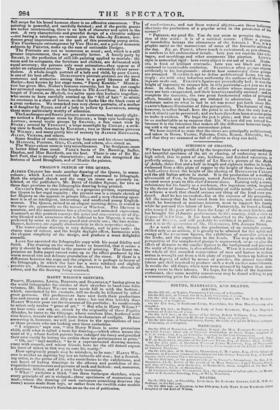HARRY WILSON'S SKETCHES.
PROM', HARDING, LEWIS, ROBERTS, and STANFIELD,• having given to the world lithographic fac-similes of their sketches in handsome folio volumes, Mr. Halm 1VissoN must needs fall in with the fashion ; which, sanctioned by his example, will no doubt be followed by other great geniuses. His predecessors have sent forth their productions five-and-twenty and even fifty at a time ; but not thus lavishly does HARRY %/mom pour out the treasures of his portfolio: he condescends to select only twelve " gems of art." " But who is Harry Wilson ? " we hear some one ask, as, struck by the originality of these Fugitive Sketches, he turns to the titlepage, whose cerulean blue, bordered with vine-leaves, reveals the artist's name in characters of sunlight. Before answering it, however, we will just listen to the speculations of two or three persons who are looking over these curiosities. " I suppose," says one, " this Harry Wilson is some precocious child, with what is called a taste for drawing,—which often means the want of it ; whose foolish parents have indulged his fancy and gratified their own vanity by letting the urchin show his performances in print." " Oh, no! "says another, " he is a superannuated drawing-master, crazy with conceit, and whose friends have let the old dotard expose his want of talent in this way to cure his vanity." flow egregiously people may be mistaken, to be sure ! HARRY WIL- SON is neither an aspiring boy nor an imbecile old man ; but a flourish. ing artist, in the prime of life, who contributes to the exhibitions, and can boast of having drawings in the albums and portfolios of dis- tinguished connoisseurs and persons of rank and fashion : and, moreover, a facetious fellow, and of a very lively invention. " What !" exclaims a third, "are these burlesque sketches, where every principle of art is violated—these specimens of mannerism run mad—where the drawing (if such caricature scratching deserves the name) seems made from toys, or rather from the twelfth-cake models • STANFIELD'S Sketches are On the eve of publication. of confectioners, and not from natural objects—are these ludicrous abortions the production of a popular artist in the possession of hie senses?"
" Patience, my good Sir. You do not seem to perceive the inten,
tion of this work : it is of a satirical nature. (Here a gesture of incredulity betrays the obtuseness of the listener.) Yes, it is s graphic satire on the mannerisms of some of the favourite artists of the day. Ex. gr. PROUT, whose touch is caricatured, as you observe is careless in his architectural details : here you see capitals like cab. bages, and mouldings and other ornaments like piecrust. Ls,-i5'5 style is somewhat rigid : here every object is cut out of wood. HARD. 1NG is fond of brilliant contrasts : here you see black and white scattered in inextricable confusion. STANFIELD often groups objects
artificially in his foregrounds : observe bow unnaturally these groups
are arranged. Homers is apt to define architectural forms too cut- tingly : see with what infantine uniformity the outlines of these build. ings are made out. TURNER'S figures are proverbially bad : it was the height of ingenuity to surpass him in this particular—yet you see it is done. In short, the faults of all the artists whose montter you can
trace are here exaggerated, and their beauties carefully omitted : and to complete the travestie, the two great fundamental rules of pictorial
effect, breadth and keeping, are violated to admiration. Such an elaborate satire on what is had in art Was never put forth since Ho. GARTH'S famous illustration of false perspective. The humour of that, however, is rather broad: here the point is so fine that the only fear is
lest it should liot be perceived ; and we have therefore been at some pains to make it evident. We hope the jest is plain ; and that no one will
be so uncharitable as to suppose that Mr. WII.SON did not intend it_.. becauseit is the intention that makes all the difference between laugh- ing with a sly wag and at the unconscious joker. We have omitted to state that the views are principally architectural, and taken in Rome, Venice, Palermo, Cala], Rouen, Abbeville, &c.; and that they are crammed as full of objects as they can hold.


























 Previous page
Previous page